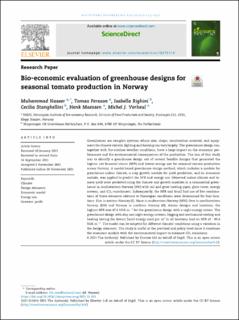| dc.description.abstract | Greenhouses are complex systems whose size, shape, construction material, and equipment for climate control, lighting and heating can vary largely. The greenhouse design can, together with the outdoor weather conditions, have a large impact on the economic performance and the environmental consequences of the production. The aim of this study was to identify a greenhouse design out of several feasible designs that generated the highest net financial return (NFR) and lowest energy use for seasonal tomato production across Norway. A model-based greenhouse design method, which includes a module for greenhouse indoor climate, a crop growth module for yield prediction, and an economic module, was applied to predict the NFR and energy use. Observed indoor climate and tomato yield were predicted using the climate and growth modules in a commercial greenhouse in southwestern Norway (SW) with rail and grow heating pipes, glass cover, energy screens, and CO2-enrichment. Subsequently, the NFR and fossil fuel use of five combinations of these elements relevant to Norwegian conditions were determined for four locations: Kise in eastern Norway (E), Mære in midwestern Norway (MW), Orre in southwestern Norway (SW) and Tromsø in northern Norway (N). Across designs and locations, the highest NFR was 47.6 NOK m−2 for the greenhouse design with a night energy screen. The greenhouse design with day and night energy screens, fogging and mechanical cooling and heating having the lowest fossil energy used per m2 in all locations had an NFR of −94.8 NOK m−2. The model can be adapted for different climatic conditions using a variation in the design elements. The study is useful at the practical and policy level since it combines the economic module with the environmental impact to measure CO2 emissions. | en_US |

